I found something special while going through old photos. Back on May 21, 2016, I photographed a leucistic striped skunk near the Ouachita National Forest. This pale-colored individual caught my attention immediately.

What Makes This Leucistic Striped Skunk Special
The skunk in my photos shows striking coloration. Instead of the typical black base coat, this individual displays predominantly white fur with some black markings remaining on the face and legs. Morning light made its already dramatic appearance even more eye-catching.
I came across it while walking a rural gravel road. The skunk paused in the middle of the path, tail raised in its classic defensive posture. It held its ground with quiet confidence before eventually moving to forage along the roadside.
Understanding Leucism in Wildlife
This leucistic striped skunk demonstrates a fascinating genetic condition. Leucism causes partial loss of pigmentation, resulting in white patches or predominantly white fur. However, it differs from albinism because the eyes retain their normal color.
The National Park Service explains the difference between these conditions well. While albinism results in complete pigment loss and pink eyes, leucism allows some normal coloration to remain.
Natural Color Variations
Striped skunks naturally show considerable variation in their white and black patterns. Some individuals display broader white areas than others. However, this level of pale coloration remains uncommon in the wild.

The skunk I photographed moved slowly through the grass, nose to the ground as it followed scent trails. Its behavior appeared completely normal despite its unusual appearance. This suggests the leucistic condition doesn’t affect the animal’s ability to survive and thrive.
This wasn’t my first encounter with leucistic wildlife in Arkansas. I also photographed a leucistic Bald Eagle that showed similar partial pigment loss but in a completely different species.

So cool! What a beautiful variation in coloring! Thank you for sharing. (I’m a fan of these “little stinkers.”)